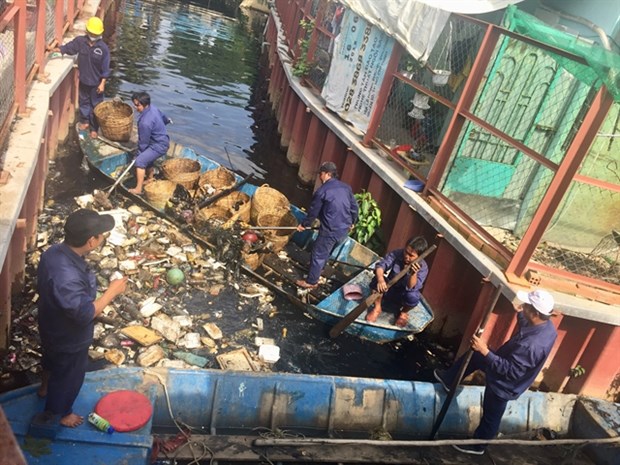 |
|
Workers remove garbage from the Ba Luu Canal in HCM City’s District 8. (Photo: VNS) |
The master plan will help ensure the city’s sustainable development, keep the environment clean, and use the available land fund effectively by developing a long-term strategy for solid waste management.
Because of the city's strong socio-economic development, the amount of solid waste generated has been constantly increasing.
The city generates 9,000-9,500 tonnes of domestic solid waste daily. Of that, about 6,500 tonnes or 69 percent is buried daily, while 2,900 tonnes or 31 percent is recycled or burned to generate electricity each day.
By 2025, the city will take steps to reduce the volume of buried waste, with the goal of burying 2,600 tonnes of waste per day.
It targets having at least 80 percent of total domestic solid waste in urban areas to be recycled for compost fertiliser or burned for electricity.
It will also collect and treat 100 percent of hazardous and non-hazardous solid industrial waste. And, all non-hazardous and hazardous medical solid waste generated by medical establishments and hospitals will be classified at source, collected and treated.
About 90 percent of construction waste will be collected and treated, of which 60 percent will be recovered for reuse or recycling.
Nearly 100 percent of sludge generated from water supply and drainage systems, wastewater treatment systems, and the dredging of canals will be collected and treated to ensure environmental sanitation.
The plan calls for solutions to sort, collect, transport, recycle and treat all types of solid waste generated in the city. It also includes measures to boost solid waste classification at source and build more waste treatment facilities.
The city is taking steps to adopt advanced waste-treatment technologies. It will invest in solid waste treatment with advanced technologies that save energy and protect the environment, and seek recycling technology that makes recycled products suited to the consumption habits of each locality.
The city’s Department of Natural Resources and Environment is also working with other departments and agencies to encourage waste treatment facilities to switch to waste-to-energy technologies, speed up investment in planned waste treatment projects, and select bidders for new waste treatment projects.
Achievements
Le Van Thinh, Secretary of Binh Tan district’s Party Committee, said the pollution situation as well as public awareness about environmental protection in the district have improved.
More than 11,460 additional dustbins were installed at public sites after a two-year implementation of a city-wide campaign that encouraged the public not to throw waste in canals and public spaces.
Of the number, 11,140 dustbins worth 8 billion VND (347,000 USD) were donated by local businesses and residents.
Over the last two years, the district removed most of the pollution “black spots”, collected 424 tonnes of waste, planted 120 additional trees along the river and canal banks, and turned 1,500sq.m vacant land areas into green spaces.
The “management of canals” model helped the district to be more proactive in dredging canals to improve the drainage system.
Nearly all 120,381 local households and 100 percent of waste owners in the district have agreed to deposit domestic waste in appropriate places and not throw waste in canals.
About 2,460 surveillance cameras were installed to enhance inspections, and promptly detect and handle littering in inappropriate places.
The district discovered nearly 300 violations and imposed fines totalling 612 million VND (26,500 USD), and handed out reminders to more than 400 other cases in the last two years.
To improve the quality of life, the district has also developed green areas and upgraded parks, and installed 130 outdoor sport equipment in 28 parks for recreational activities.
Challenges
According to the city’s Department of Natural Resources and Environment, the classification of household solid waste at source has generally been working well, but not at all places, causing difficulties for waste treatment facilities.
The city has no large-scale recycling plant, so solid waste has to be sorted and treated at small-scale 10 recycling plants and 1,800 household facilities.
The city has two main treatment complexes, the 614-ha Da Phuoc Waste Treatment Complex in Binh Chanh district and the 687-ha Phuoc Hiep plant in Cu Chi district.
The city has closed two landfill sites in an effort to reduce the burial of solid waste, including the 25-ha Go Cat in Binh Tan District and the 45-ha Dong Thanh in Hoc Mon district.
The Da Phuoc Waste Treatment Complex receives and treats more than 5,000 tonnes of waste a day, with most of it now buried. It is scheduled to be closed in 2024 because it has exceeded its designed capacity.
Ninety percent of the Da Phuoc landfill site is at risk of flooding, according to research done by the Asian Development Bank (ADB). This causes environmental pollution at the landfill and pollutant dispersion to surrounding areas.
Climate change and natural disasters like storms and floods also affect waste-treatment management work, as well as the lifespan and productivity of equipment.
The city needs to include solutions for climate change adaptation in its solid waste management and treatment master plan, experts said. It also needs further investment in waste collection, transport and treatment systems to keep pace with the city's rapid economic growth./.VNS